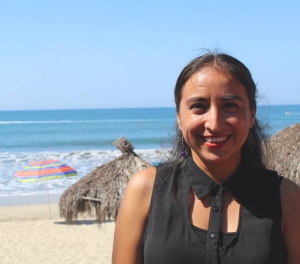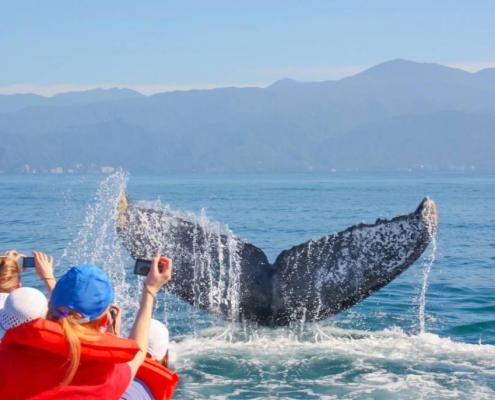Whale watching should be a responsible activity
- The Riviera Nayarit remains committed to caring for the environment and promoting sustainable tourism by supporting service providers that respect best practices for sightings.
Whale watching is a favorite activity in the Riviera Nayarit, but it must be done in a responsible and sustainable manner so as to avoid a negative impact on the cetacean population, according to Marine Biologist Iyari Espinoza, a member of the Marine Mammals Research Program, or GRIMMA, by its acronym in Spanish.
A professor of Science and Oceanology for the Tecnológico Nacional de México Banderas Bay Campus, Espinoza also mentioned Mexico is a pioneer in cetacean protection programs, particularly for the gray whale. This protection has been extended to other species, including the humpback whales that visit the coast of Nayarit.

However, it’s important to note that in order to protect these creatures, the number of individuals that visit Banderas Bay must be noted along with their habits and behavior, and above all, the dangers that await them.
“The biodiversity of the region is at risk because of the increased human activity,” said Espinoza. “This is why we must have preventative measures in place immediately.”
Monitoring program
This is why the team recently began the “Population analysis of two species of cetaceans in Banderas Bay” project, which includes the humpback whale and the Tursiops truncatus dolphin, or bottlenose, as it’s commonly known.
This project is ongoing thanks to the support of the Punta de Mita Foundation, which awarded the funds necessary to enact the necessary monitoring for this year, enacted along with the Tecnológico Nacional de México Banderas Bay Campus and Corazón de Mar.
The project is focused mainly on the cetaceans found along the coastlines of Nayarit and Jalisco, that is to say, dolphins, whales, and other Odontocetes in Banderas Bay and the surrounding areas.
Espinoza pointed out that the first whale and dolphin registry began back in early 2000 and it’s been 20 years, which is why this initiative is so important.

MC Iyari Espinoza
“GRIMMA considers these monitoring programs to be very important, because that way we know what conditions these two species are in. The dolphin is here for the entire season and the whales are only around from December through March; however, this is also high season for tourism. We must keep in mind the whales come here to reproduce, but sadly, their breeding ground is under intense tourist pressure because of its location along the coast.”
Espinoza explained the whales generally seek shallow areas like those in the northern part of the bay. These are especially frequented by whales with young, where they go to teach their calves to breathe.
She reiterated that it’s very important to keep this area free as the calves are receiving their first life lessons and mustn’t be distracted.
Respect the regulations
When whale watching began back in the 90s, a standard was proposed that at first only covered the gray whale but was later extended to include the humpbacks. This norm—NOM 131 Semarnat 2010—sets out the guidelines that must be followed to correctly carry out the observation of whales by tour boats.

Espinoza added that the Mexican Standard indicates there must be a strict line drawn two kilometers from the coastline to where the waves break where no whale watching is permitted. However, there are some boats that flout this regulation, perhaps due to ignorance or because, as the whales are already there, they do not want to lose their tourist dollars.
Fifty percent of the boats in the bay are privately owned, which is why it’s so important for them to know the rules. Unfortunately, they are not always followed by the boat owners and the entity in charge of enforcement—Profepa—does not have enough manpower or funds to ensure compliance.
To that end, GRIMMA’s most recent project will not only monitor the number of whales per square kilometer and where they are concentrated but will also help inform tourists and tour operators about the rules and regulations so they have the tools they need to do the right thing.
2020-2021 Whale Watching Season
December 8 marked the official start of Whale Season in the state of Nayarit and it runs through March 23, 2021. Whales can be seen in the municipalities of Bahía de Banderas (and the homonymous bay); Compostela (Rincón de Guayabitos-Peñita Jaltemba-Chacala); and San Blas (San Blas and Isla Isabel), which is why it’s important for service providers to follow the set guidelines:

+ How to observe whales: Stay at least 100 meters from large whales and 50 meters from the dolphins.
+ The speed at which they can travel through the bay.
+ The maximum number of boats that can engage in this activity. The presence of more than one boat at a time is not recommended.
+ Avoid sudden and repeated changes of direction, and excessive use of the motor, maneuvers, gear, and speed changes when close to these marine mammals.
+ The time allotted to be close to a group of whales so other boats can have a chance to see the whales, and last but not least:
+ Let the whales rest.
The Riviera Nayarit remains committed to caring for the environment and promoting sustainable tourism by supporting service providers that respect best practices for whale watching. It is also important that local and domestic tourists follow the recommendations issued by service providers on their boats. All sanitary protocols established by the Federal Government’s Ministry of Health are being followed for whale watching tours.
We’re ready!
###
The Riviera Nayarit Convention and Visitors Bureau (CVB) and the Bahía de Banderas Hotel and Motel Association (AHMBB) are hard at work to joingly promote the region with the support of the Government of the State of Nayarit through its Tourism Promotion Trust (Fiprotur).



